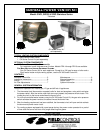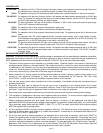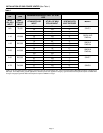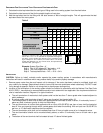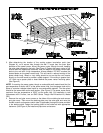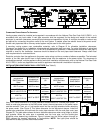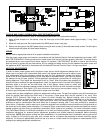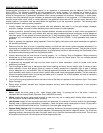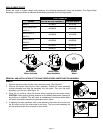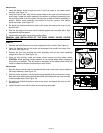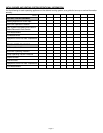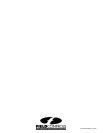
Page 8
GENERAL INSTALLATION INSPECTION
Recommended procedures for safety inspection of an appliance in accordance with the National Fuel Gas Code
A.N.S.I.Z223.1. The following procedure will help evaluate the venting system. It is intended as a guide to aid in
determining that the venting system is properly installed and is in a safe condition for continuous use. This procedure
should be recognized as a generalized procedure which cannot anticipate all situations. Accordingly, in some cases,
deviation from this procedure may be necessary to determine safe operation of the equipment. If it is determined that a
condition exists which could result in unsafe operation, the appliance should be shut off and the owner advised of the
unsafe condition. Corrections must be made before the appliance is put into continuous operation. The following steps
should be followed in making a safety inspection.
1. Visually inspect the venting system for proper size and determine that there is no flue gas spillage, blockage,
restriction, leakage, corrosion or other deficiency which could cause an unsafe operation.
2. Insofar as practical, close all building doors, fireplace dampers, windows and all doors in area in which the appliance is
located. Turn on clothes dryers, any exhaust fans, such as range hoods and bathroom exhausters so they operate at
maximum speed. Do not operate a summer exhaust fan. If, after completing Steps 3 through 7 it is believed sufficient
combustion air is not available, refer to the National Flue Gas Code A.N.S.I.Z223.1, or any applicable local codes for
guidance.
3. Place in operation the appliance being inspected. Follow the lighting instructions and adjust thermostat so appliance
will operate continuously.
4. Determine that the pilot or burner is operating properly and that the main burner ignition operates satisfactorily, by
interrupting and re-establishing the electrical power of the appliance in any convenient manner. Test the pilot or burner
safety device to determine if it is operating properly by extinguishing the pilot or disconnecting the flame safety circuit
and pressure switch sensing tube from the pressure switch.
5. Visually determine that the main burner is burning properly; i.e., no floating, lifting or flashbacks. When performing
smoke test on oil-fired systems, the burner should operate at a zero to a trace smoke. This can indicate reduced
available combustion air to burner.
6. If appliances are equipped with high and low flame control or flame modulation, check for proper main burner
operation at low flame.
7. Test for spillage at draft hood or barometric draft control opening and burnr inlet air location after 5 minutes of main
burner operation. Use a draft gauge, flame of a match or candle, smoke from a cigarette, cigar or pipe. If spillage
occurs, adequate air is not available. Shut off heating appliance thermostat and check for spillage around the draft
hood, barometric draft control or burner inlet air location after power venter has stopped operation. If a flow reversal is
noticed, house de-pressurization is occurring and make up air is required. For oil-fired systems, this may be noticed by
oil fume smell after post purge cycle.
8. Turn on all fuel burning appliances within the same room so that they will operate at their maximum input. Then repeat
Steps 5 through 7.
9. Return doors, windows, exhaust fans, fireplace dampers and any other fuel-burning appliances to their previous
condition of use.
MAINTENANCE
1. Motor: Inspect the motor once a year - motor should rotate freely. To prolong the life of the motor, it must be
lubricated with six drops of SWG Superlube, Part # 46226200, annually.
2. Wheel: Inspect the power venter wheel annually to clear any soot, ash or coating which inhibits either rotation or air
flow. Remove all foreign materials before operating.
3. Vent System: Inspect all vent connections annually for looseness, for evidence of corrosion and for flue gas leakage.
Replace, seal or tighten pipe connections if necessary. Check the power venter choke plate to insure it is secured in
place. Check the barometric draft control, if installed, to insure the gate swings freely.
4. System Safety Devices: With the heating system operating, disconnect the pressure sensing tube from the pressure
switch on the CK Kit. This will stop the burner operation. Re-connecting the tube will relight the burner. For 30 millivolt
operating systems, disconnect one lead of the spill switch circuit from the thermocouple junction block. This will shut
off the pilot and the burner. Re-connection will allow relighting the pilot.



